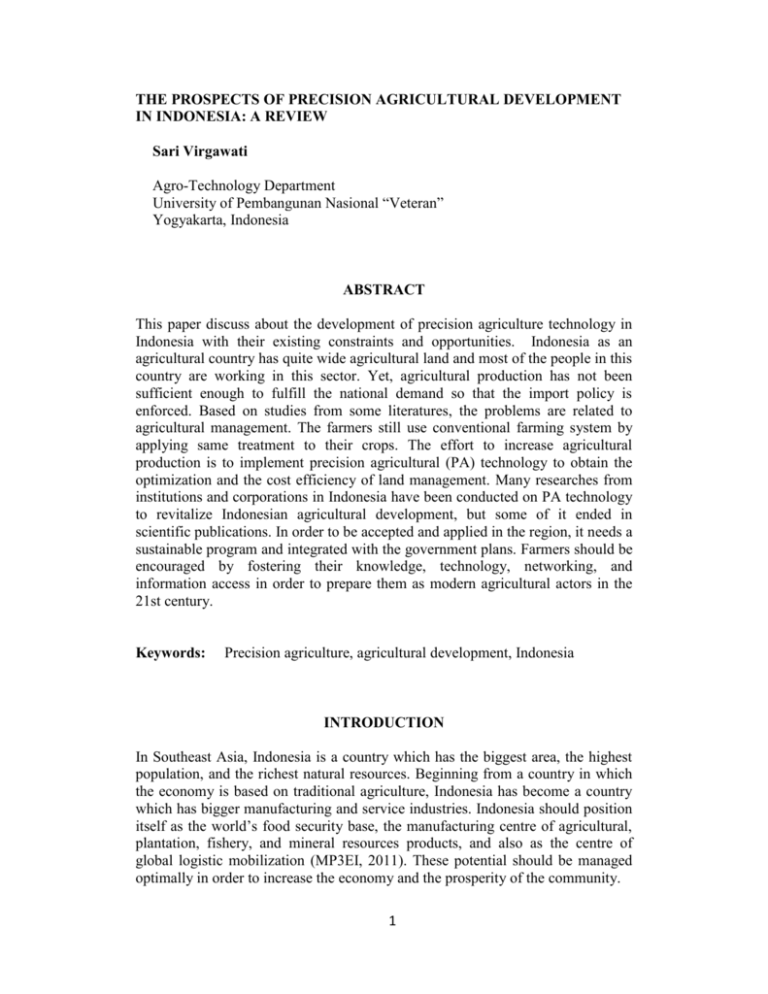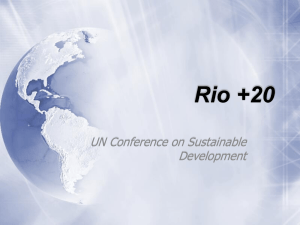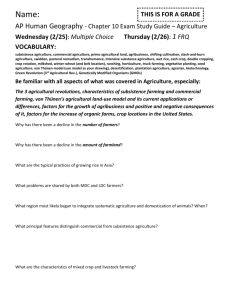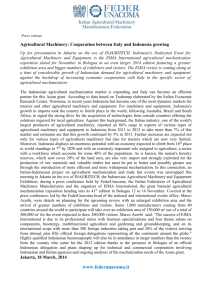THE PROSPECTS OF PRECISION AGRICULTURAL
advertisement

THE PROSPECTS OF PRECISION AGRICULTURAL DEVELOPMENT IN INDONESIA: A REVIEW Sari Virgawati Agro-Technology Department University of Pembangunan Nasional “Veteran” Yogyakarta, Indonesia ABSTRACT This paper discuss about the development of precision agriculture technology in Indonesia with their existing constraints and opportunities. Indonesia as an agricultural country has quite wide agricultural land and most of the people in this country are working in this sector. Yet, agricultural production has not been sufficient enough to fulfill the national demand so that the import policy is enforced. Based on studies from some literatures, the problems are related to agricultural management. The farmers still use conventional farming system by applying same treatment to their crops. The effort to increase agricultural production is to implement precision agricultural (PA) technology to obtain the optimization and the cost efficiency of land management. Many researches from institutions and corporations in Indonesia have been conducted on PA technology to revitalize Indonesian agricultural development, but some of it ended in scientific publications. In order to be accepted and applied in the region, it needs a sustainable program and integrated with the government plans. Farmers should be encouraged by fostering their knowledge, technology, networking, and information access in order to prepare them as modern agricultural actors in the 21st century. Keywords: Precision agriculture, agricultural development, Indonesia INTRODUCTION In Southeast Asia, Indonesia is a country which has the biggest area, the highest population, and the richest natural resources. Beginning from a country in which the economy is based on traditional agriculture, Indonesia has become a country which has bigger manufacturing and service industries. Indonesia should position itself as the world’s food security base, the manufacturing centre of agricultural, plantation, fishery, and mineral resources products, and also as the centre of global logistic mobilization (MP3EI, 2011). These potential should be managed optimally in order to increase the economy and the prosperity of the community. 1 Fig. 1. Population density of Indonesia by province (BPS, 2012) Recorded from BPS (2012), the number of population by census in 2010 was 237,556,363 people and about 58% was concentrated in Java Island. Figure 1 shows the population density in Indonesia. The rice harvest area in 2011 was 13,201,316 hectare, and rice productivity was 4.98 ton/hectare (BPS, 2012). However, for more than three decades, domestic rice production was not able to meet its growing demand, so that Indonesia remains dependent upon rice import. This condition was made worse by conversion of fertile lowland (Swastika et al., 2007). Climate change issue, limited resources, food security and global free trade will inevitably force Indonesian agriculture toward agricultural industrialization. The aim of food and agriculture policy in Indonesia is to realize a competitive nation by making efficiency, modernization, and increasing agricultural value so that it can compete in local and international market for strengthening the food security (Harjanto, 2011). The development of domestic production capability needs to be supported by food security institution that can guarantee the sufficiency of food requirement in the household level, including the quantity, the quality, the security, and also the affordable price, from many kind of local food resources. To overcome this problem, the implementation of precision agricultural (PA) technology can be the best solution. PA which has been growing rapidly in several countries in the world aims to reduce the environmental impact of agricultural activities but at the same time to increase productivity, by optimizing the input and output and maintaining soil quality through the appropriate level of technology. 2 THE IMPORTANCE OF PRECISION AGRICULTURE DEVELOPMENT The problem of agricultural land reduction must be handled by increasing the production through intensification, while climate change requires an eco-friendly agriculture system. Agricultural products that cannot fulfill international quality standard will not be accepted in the global market. This requires a careful treatment in all of the agribusiness chain structure starting from on-farm activity until off-farm activity. Agricultural paradigm that gives careful or precision treatment is Precision Agriculture (PA), in order to obtain optimization for the land management, thus land management cost can be efficient. PA as technology should be developed immediately in Indonesia in order to give more opportunities for more precise treatment toward every parts of land, so that it can increase the productivity level by increasing the product result, pressing the production cost and reducing the environmental effect. The implementation of this technology considers land, social, and cultural factors including its local wisdom, and also farming benefits but it is still concerned with the land conservation. Thus, the implementation of this technology is expected to be able to fulfill the balance of three integrated subject, which are (Virgawati et al., 2010): a. Sustainable economic development through the addition of food product value and the increase of food product output. b. Social justice through the equality of rights and opportunities to access efficient technology in the food production system. c. Environmental conservation especially natural resources conservation which means to conserve land by preserving its fertility. PA applies soil and plant sample collecting in order to obtain information about how are the varieties of condition in the land. PA technology can be used in all of the plant production cycle aspects starting from pre-planting operation until harvesting activity. This technology is now available for soil testing, soil tillage, planting, fertilizing, spraying, crop scouting, and harvesting. The practical use of PA needs a good integrated system approach that combines hard technology with soft systems (Prabawa, 2006). This can be achieved through designing activities of yield map, soil map, growth map, field information map, determining variable rate application, inventing yield censor, variable rate applicator, and so on. PROBLEMS ON PRECISION AGRICULTURE DEVELOPMENT Based on studies from some literatures, the agricultural development problems in Indonesia are related to agricultural management. The farmers still use conventional farming system by applying same treatment to their crops. Fertilization practice does not consider spatial variability of soil fertility. The implications of this practice are wasting of fertilizer, decreasing productivity, increasing production cost, decreasing profit, and giving negative impact to the environment (Prabawa, 2006). Low capital and limited knowledge of technology in the farmer level are also constraints in PA development. Things that are related with precision technology are often defined as an expensive and unreachable technology. PA has many challenges as a plant 3 production system so that it needs many technologies that have to be developed in order to be adopted by the farmers. According to Tooy (2008), the problem in Indonesia is more intense on the inconsistency of determining program orientation and the seriousness to implement it. The existing technology has not been utilized optimally, possibly because it is still considered as an experiment. Saragih (2011), the Chief Executive of International Farmer Organization (La Via Campesina), observes it that the concept of PA can only be implemented by agribusiness companies that have capability to use expensive technologies and have wide area of land, not by the farmers that are still having trouble with limited capital and access, and also low level of land ownership. In the future, it is not impossible to have a thousand hectare of field that is handled with capable technology and management, and have high productivity, but it is owned by private institutions similar to what is happening in oil palm plantation. This will eliminate small farmers; exacerbate social, knowledge, and education imbalance (Mubarok, 2011). RESEARCH ON PRECISION AGRICULTURE TECHNOLOGY According to Darmawan et al. (2007), the development of PA in developing country is still a discourse, except in India. Mostly, PA strategy in Indonesia is implemented in partial researches. While looking at technology mastery, Indonesia has developed the RS/GIS, DSS, and ICT. Mubarok (2011) records, at least there are some progresses on agricultural technology development, e.g.: a. Agricultural automation technology The development of technology which based on microcontroller to control automatically which has high accuracy level and high precision level to be applied in agricultural sector. b. Agricultural E-commerce The market expansion through internet network, online transaction that can increase the agricultural product competitiveness. c. Information system technology Technology of prediction and analysis of agricultural data by using artificial neural network, database system, image processing, and so on that are upgraded continually in order to be integrated with the other agricultural system and machine. d. Agricultural policy Socialization and application of agricultural technology toward the community need capability, energy, fund, and support from government policy. The technology capability has to be tested immediately by introducing it to the farmers so that they can utilize it. Several research products that are still in the process of improvement and have been improved to support agricultural development toward PA in Indonesia are listed on Table 1. 4 Table 1. Research products to support precision agriculture No. Name of product Institute / Company Status 1. 2. Nutrient Manager for Rice e-petani (e-farmer) 3. Cyber extension 4. Automated irrigation system Sensor to detect soil Phosphate Remote sensing for Chlorophyll identification UV and near infrared images for leaf area identification Assembly humidity sensor using nanotechnology UAV for rapid aerial photo system Efficient rice seeding machine Digital image and automatic control on planter Real time VRA using camera 8 bit microcontroller to upgrade VRA precision GIS mapping C and N status on rice parcel GIS mapping NPK status on Sugarcane plantation Digital Mapping of natural resources Planting calendar for rice (sub-district level) IRRI and Gov. (Agric. Dept.- research division) FEATI and Gov. (Agric. Dept.) Gov. (Agric. Dept.extension division) Univ. of Agric., Bogor launched via internet/SMS launched via internet launched via internet research Indonesian Institute of Science Sam Ratulangi Univ. (North Sulawesi) research SGU Asia, Jakarta research Gov. (Agric. Dept.hydrology division) research Inst. of Technology, Bandung Gov. (Agric. Dept.machinery division) Univ. of Andalas, West Sumatera research Univ. of Agric., Bogor research Univ. of Agric., Bogor research UPN Veteran Yogyakarta research Univ. Lampung, Sumatera research Gov. (Coord. Agency of Survey and Mapping) Gov. (Agric. Dept. – research div.) launched via internet launched via internet 5. 6. 7. 8. 9. 10. 11. 12. 13. 14. 15 16. 17. 5 research ready to use research Many researches from institutions and corporations in Indonesia have been conducted on PA technology to revitalize Indonesian agricultural development, but some of it ended in scientific publications. In order to be accepted and applied in the region, it needs a sustainable program and integrated with the government plans. PRECISION AGRICULTURE APPROACH ON FARMER LEVEL The best linkage of the wisdom farmers and the technology platform would produce information-oriented fields and information-added products that encourage multi-functions of agriculture creating new value-chains in the agroproduction-consumption system (Shibusawa, 2003). Precision Farming being a management approach not just a technology can equally be applied to developing countries as well as developed countries, but the implementation is different. If technology is needed they should be used to complement the traditional methods for enhancing productivity and quality, rather than to replace the local conventional methods (Griepentorg and Blackmore, 2004). The improvement of farmers’ management skill through the accumulation of data and information is an important aspect of PA system and it has been integrated into the development and dissemination of rice integrated crop management in a number of developing countries (Tran and Nguyen, 2006). Virgawati, et al. (2010, 2011) have conducted a preliminary research to implement PA using a learning media that fit to local wisdom so-called the Centre of Farmer Learning Activities (CFLA). This activity is related with the government program, Field School for Integrated Crop Management, an extension method of agricultural technology dissemination that has been considered as the most effective one, and the best approach to accelerating farmers' understanding and adoption process. CFLA try to motivate the farmers in improving their knowledge of PA and build environmental friendly farming communities by involving them in the PA research in their farm. In CFLA, the groups manage some extension activities used learning by doing method, focused on managerial capacity development, leadership and entrepreneurship, and create innovative farmers. Technically, information dissemination program on the lower level (village) has been performed effectively by the existence of farming group institution. However, the traditional ways of socialization such as agricultural extension program need to be improved with technical assistance and facilitation to access information and technology. Farmers should be encouraged by fostering their knowledge in order to prepare them as modern agricultural actors in the 21st century. Agricultural extension actors and farmers must be empowered with ICT understanding so that they can access necessary information from its sources fast, accurately, and efficiently for the decision making on agricultural activity management. Learning activity, networking, or marketing can be performed in the community-based form as an interaction activity in the agricultural institution 6 function empowering. ICT utilization can help improving the PA development that produce social-economic benefits and also creating opportunities for improving farmers’ prosperity. Finally, the implementation of PA should be supported by development and renovation of infrastructures as well as establishment of credit scheme to enable farmers to adopt modern technology. CONCLUSION The development of precision agriculture cannot be separated from the advance of technology which is dynamic in accordance with the dynamic of environment and market demand. Therefore, PA research still play some part in the future agricultural development policy which is focused not only on the effort of inventing new technology but also on its technology dissemination so that it can reach and can be implemented on the farmer level. The implementation of PA is still partial because of lack of coordination between institutions and the need of strategic road map and complete planning for long term. Rapid advance in the technology of remote sensing, SIG, ICT, and DSS at the present time is a positive stimulation for the implementation of PA in Indonesia. In this case, commitment and cooperation between universities, regional governments, companies, and farmers need to be increased in order to be able to reach that goal. It is expected that the symbiosis of roles between researchers/innovators from universities, policy planner from the government, facilitators from agricultural industries, and farmers as the agricultural actors becomes synchronic and more focused to achieve a sustainable agricultural development. REFERENCES BPS. 2012. Badan Pusat Statistik (Statistics Indonesia). http://bps.go.id (accessed 23 April 2012). Darmawan, S., I.H. Ismullah, K. Wikantika, and F. Hadi. 2007. Precision farming as decision support system. (In Indonesian.) Remote Sensing: Saving our earth for your future. http://sonidarmawan.multiply.com/journal/item/3?& show_interstitial=1&u=%2Fjournal%2Fitem (accessed 24 April 2012). Griepentorg, H.W., Blackmore, B.S. 2004. Sustainable agriculture and precision farming in developing countries. http://www.tropentag.de/2004/proceedings/ node153.html (accessed 2 June 2011). Harjanto, J.T., 2011. Precision agriculture toward sustainable food sovereignty. (In Indonesian.) Ministry of Agriculture, Rep. of Indonesia. http://bppsdmp. deptan.go.id/index.php?Option=com_content&view=article&id=313:pertanianpresisi-menuju-kedaulatan-pangan-berkelanjutan&catid=77:artikel-sekretariat& Itemid=206 (accessed 23 April 2012). 7 MP3EI. 2011. Masterplan: Acceleration and extension of Indonesian economy development 2011-2025. (In Indonesian). Ministry of Economic Coordinator, Rep. of Indonesia. http://www.depkeu.go.id/ind/others/ bakohumas/Bakohumaskemenko/MP3EI_revisi-complete_(20mei11).pdf (accessed 23 April 2012). Mubarok, Hasbi, 2011. Precision agriculture in Indonesia: for who? (In Indonesian.) http://biotechnoworld.wordpress.com/2011/12/12/pertanian-presisi -indonesia-untuk-siapa/ (accessed 25 April 2012). Prabawa, Sigit. 2006. Precision farming approach in N,P, and K fertilizing on sugarcane cultivation: case study at PT. Gula Putih Mataram. (In Indonesian, with English abstract.) Ph.D. diss., IPB, Bogor. Saragih, Henry. 2011. Agricultural technology does not promise farmer’s welfare. (In Indonesian.) http://www.spi.or.id/?P=4486 (accessed 24 April 2012). Shibusawa, Sakae. 2003. Precision Farming Japan Model. Agricultural Information Research 12 (2), 125-133. JSAI, Japan. Swastika, D.K.S., J. Wargiono, Soejitno, and A. Hasanuddin 2007. Analysis of policy on increasing rice production by efficiency of rice field utilization in Indonesia (In Indonesian, with English abstract.) Analisis Kebijakan Pert. 5(1):36-52. PSE, Ministry of Agriculture, Rep. of Indonesia. Tooy, Dedie. 2008. Opportunities on precision technology in agricultural revitalization. (In Indonesian.) http://www.hariankomentar.com/arsip/arsip_ 2008 /mar_27/opini01.html (accessed 24 April 2012). Tran, D.V., N.V. Nguyen. 2006. The concept and implementation of precision farming and rice integrated crop management systems for sustainable production in the twenty-first century. International Rice Commission Newsletter, Vol. 55, 2006. p. 91-113. FAO, Rome. Virgawati, S., S. Sumarsih., W. Choiriyati, D. Nuryadin, E. Murdiyanto, F.R. Kodong, and H. Lukito. 2010. Centre of community learning activity as the media for technology of precision farming implementation with DSS to optimized the food crop management. (In Indonesian.) ESD research report. LPPM-UPN, Yogyakarta. Virgawati, S., S. Sumarsih. W. Choiriyati, D. Nuryadin, E. Murdiyanto, F.R. Kodong, and H. Lukito. 2011. Centre of farmers learning activity based on ESD as the media for precision agriculture technology implementation (Social experiment on community-based precision paddy in Central Java, Indonesia). Paper presented at: the 4th ACPA, Obihiro, Japan, 4-7 July. 8








